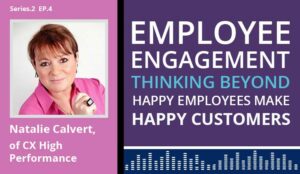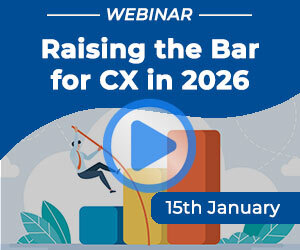You’re about to go in front of the board and you’re looking to get their approval to enter in to a customer experience improvement programme. Natalie Calvert explores how you should make your case.
You know it makes sense – and in your heart you know your organisation agrees that the customer experience should be the best possible. But that’s often where it ends; getting the real buy-in often means expenditure – something that, in this day and age, is often tough to get sign-off on.
So how do you get that real commitment? There are three golden rules that, if you follow them closely, will deliver the goods.
“Make sure you provide valuable insights in to how your customers react and behave to your actions”
Rule 1: The customer is king
Fundamentally, improved customer experience is a way of saying great customer service. Therefore, getting buy-in is all about showing the impact of delivering great customer service.
My advice is to take the voice and potential behaviour of your customers in to the boardroom with two parameters: firstly, what could happen if you DO and then followed swiftly by what will happen if you DON’T take a particular course of action.
Make sure you provide valuable insights in to how your customers react and behave to your actions – both now and in the future. Using real tapes, video and experiences to bring the points home is invaluable.
Where possible, conduct a pilot before going for full roll-out of a new idea so you can assess the total impact. Most pilots need to run for at least three months to ensure it’s not just a halo effect and that they are sustainable. This will give you the evidence to show that what you seek to do will be a winning strategy.
- Positive impacts of action
- Higher value and loyalty
- Satisfaction
- PR
- Advocacy
- Efficiency
- Potential downsides of no action
- Lower margins
- Competitive advantage
- Negative brand perception
- Defection
- Reduced performance
Running a pilot becomes even more critical with outbound activity so that you can establish key metrics for success, for instance:
- Best times to contact
- Conversion rates
- Data requirements
- Customer satisfaction
- Employee satisfaction
- Regional variations
- Results
Additionally, third party research is a great way to validate a point you might make. The Institute of Customer Service, for instance, has produced an excellent research paper in conjunction with Warwick University called the ‘Service Profit Chain’. (For a copy, go to www.instituteofcustomerservice.com)
Rule 2: The money does the talking
Remember most boards and departments are measured, or even bonused in many cases, by at least four of the seven items mentioned below:
- Share price
- Revenue
- Profits
- Cost savings
- Employee satisfaction or profit per employee
- Customer satisfaction
- Industry-specific measures, for instance, crime rates for police or churn for mobile operators
The key here is to link what you are doing to monetary value and clearly show the impact of what the investment required will deliver in the longer term to achieve business targets and bonuses:
- Cost saving
- Increased profits
- Employee to value ratio (E2V)
Here at Calcom, we’ve been evaluating the E2V over several years as a robust method of assessing the value of an employee in particular roles and at specific levels in an organisation. We’ve found that it is a great way to determine the true cost and return of an employee and what is it that creates employee value in terms of cost, productivity, loyalty and performance. Getting your E2V right can increase overall employee capability by over 20%, but more of that in a later article.
Rule 3: Forget the contact centre
Unfortunately most of our call and contact centre conversations are as if they were from another planet. We talk about strange things like grade of service, abandoned calls, workforce management and so on.
I remember once seeing a significant presentation where several million pounds were being asked for and the main business case was around ETET. Now that’s fine if you know, understand and care about ETET, but most board members frankly don’t realise the impact of ‘ear to ear time’.
So my message here is simple: don’t mention the contact centre. Instead, focus on your customers, your employees and your bottom line. Don’t focus on the contact centre nuts and bolts – sell the lifestyle, not the house or the bricks.
Some thoughts to consider for your presentation
So, we’ve looked at the three golden rules. But what now? Below I’ve listed what I consider to be three important considerations when you’re finally ready to present to the board.
1) We are all different – well nearly
It is generally accepted that there are four main ways that we absorb information:
- Visual – I saw
- Verbal – I heard
- Emotion – I felt
- Logical – It added up
So think about your board or department colleagues. Who absorbs information in what way and how should you present it?
- Who is drawing diagrams, painting pictures or never has the time to read your documents?
- Who is the talker who also sits and listens?
- Who is led by the ‘yes, that feels right’ intuition factor?
- Who needed to see it all stack up, and needs to see the detail and numbers?
Of course, some people can have a couple of traits – but try the exercise of establishing how your team behave.
Understand your audience and then create your documents to ensure you have a well-planned story that contains pictures, diagrams, numbers and an emotional pull. One client of ours always uses pictures of the boss’s children; another always plays a tape of something outrageously funny to get the point across.
2) Meetings outside the meeting
In excess of 80% of your job of ‘selling your ideas’ will be done before the meeting, so make sure you identify your key stakeholders, assassins, challengers and allies. Build in time to get people’s opinions and share thoughts in advance so you can handle your objectors and make sure your allies are on board. You might even want to enrol the help of a couple of ‘really good colleagues’ to help with some of those awkward people or more senior stakeholders.
3) The POWER of YOU!
Your job will be to drive this project. Perhaps even your future career is dependant on it. Remember: if you are not enthusiastic and passionate, no one else will be. You will have to win hearts as well as minds.
I recently heard Jack Walsh, the billionaire founder of one of the world’s most successful organisations General Electric, say:

“I have never had a board presentation that delivered less than 20% improvement. In fact, if all the 20%s added up, then we would have been 10 times more successful. What made me say yes or no was looking in the eyes of the project owner and seeing if they believed it or not.”
So ensure you have that belief and don’t underestimate the POWER of YOU!
Natalie Calvert is managing director at the consultancy Calcom Group
The following comments have been posted relating to this article:
A CLEAR ROADMAP AND THEY LOOK VERY LOGICAL. DOES EACH RULE SUGGESTED HAVE AN EQUAL WEIGHTING IN THE PROCESS?
Hi – the answer depends on the make up of your board – if for example they are all accountants then the financial case would definitely outweigh the other rule by about 10:1. However, for a fully rounded approach I would recommend equal weighting – after all it’s how you tell the story that counts! Remember don’t give them ‘data’ give them information that equals a powerful argument in favour of delivering brilliant customer experiences – consistently! Please do drop me a line if you’d like further details or guidance. Good Luck Natalie (posted by Natalie Calvert)
Author: Natalie Calvert
Reviewed by: Jonty Pearce
Published On: 5th May 2007 - Last modified: 15th Aug 2025
Read more about - Customer Service Strategy, Customer Experience (CX), Customer Service, Natalie Calvert, Service Strategy







































